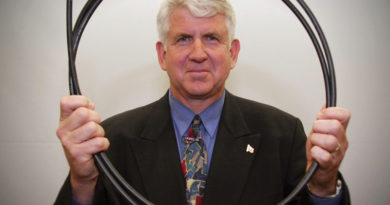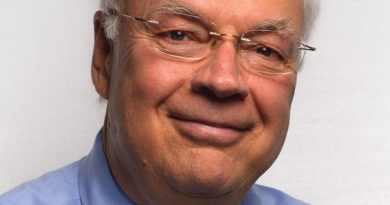Getting to Yes on Energy 2020
By Ron Rizzuto
A Large ROI for the Future… Getting to Yes on Energy 2020
During the past two years I have been involved with SCTE/ISBE’s Energy 2020 project. This project is an extremely important undertaking for the industry and I applaud SCTE/ISBE and the leaders in the industry who have spearheaded this undertaking. It is energizing and exciting to witness the technologists in the industry, both cable operators and technology partners, who have come together to collaborate and share ideas for achieving the objectives of Energy 2020. I have been fortunate to participate as a member of some of the Energy 2020 subcommittees, including the ‘financial modeling’ subcommittee, and to watch this effort first hand.
The Energy 2020 subcommittees have made great progress over the past two years in: identifying best practices, setting standards for best practices, developing benchmarks and metrics on energy usage as well as identifying investment alternatives. Over the next couple of years, the Energy 2020 subcommittees will increasingly view the various energy saving and network migration options through the ‘language and lens of business, finance, and operations’ in addition to the technology1.
This plethora of investment ideas that the subcommittees have developed and will develop in the future will be evaluated using either one of the following financial/analytical frameworks:
Lifetime cost comparisons models —
Net present value (NPV) of costs — operating expenditures (OPEX) and capital expenditures (CAPEX)2. This type of model is frequently used when there are alternative technologies for accomplishing a task (e.g., LED linear tubes vs. fluorescent lighting fixtures; use of fuel cells or solar energy to power cable facilities vs. reliance on the power grid; integrated, converged cable access platform (CCAP), technology vs. traditional CMTS and edge-QAM modulator technology). The typical tradeoff in such evaluations is that the more energy efficient alternative requires more CAPEX than the less energy efficient alternative, however, OPEX is lower with the more energy efficient alternative. Of course, the alternative that produces the lowest NPV of costs is the preferred alternative from a financial perspective.
Network migration models —
Comparisons of the NPV of the costs of the various options for migrating todays network to the network of the future. Since, as SCTE/ISBE’s Power Pyramid illustrates, 73-83 percent of the industry’s energy consumption is in access network power supplies and edge facilities, it is imperative to consider the options for migrating the network.
Some examples of network migration options are include: HFC upgrade with node splits; HFC to FTTx transitions (where FTTC is fiber-to-the-curb; FTTT is fiber-to-the-tap; FTTLA is fiber-to-the-last-active, FTTP is fiber to the premises, using a passive optical network (PON) or RF over glass (RFoG) architecture); and fiber deep with distributed access architectures such as remote PHY or remote MAC/PHY3.
The key differences between lifetime cost models and network migration models are that migration models: 1) will include many investments considered collectively rather than a single investment like lifetime models; 2) might include revenues in addition to costs if the various options enable different business opportunities4; and 3) may require more judgment as to the terminal value since the terminal period can be postponed or extended by adding additional investments to the end of the life of the migration option.
The various network migration options need to be evaluated using a decision framework that includes the following criteria:
- NPV of the costs for the option
- Capabilities of the option for providing the necessary bandwidth, throughput, and services to customers
- Energy usage, cost, dependency on the power grid, and optimization of the footprints of technical facilities
- Size and significance of the investment to overall value of the MSO (i.e., how much value does the investment create for the MSO?)
- Impact on the competitive position of the MSO
- Impact on the operations of the MSO
- Impact on the customer experience
- Optionality — ability to adjust the migration path given changes in the environment
This 360 degree evaluation of network migration options will, as Dan Pike stated, enable investments to be viewed with the ‘language and lens of business, finance, and operations’ in addition to the technology.
Many of these same criteria need to be considered in evaluating lifetime cost comparison models, however, decision criteria 1, 3, 4, 6 and 7 are probably the most critical criteria to consider.
This is an ‘inflection point’ for the industry in terms of network migration. The industry is looking to migrate the network to accommodate: the explosive growth in the demand for bandwidth — Internet of Things (IoT), 1 Gig competitive and marketing pressures, the need for speed, wireless capabilities, 4k video, virtual reality and other new applications. The recent history of the industry and the future outlook suggests that Nielsen’s Law of Internet Bandwidth, that network connections speeds will increase 50 percent per year, is alive and well in the industry.
The timing of SCTE/ISBE’s Energy 2020 Project is fortuitous as a result of this industry inflection point. It’s been noted that by the end of the decade the industry’s power usage is expected to grow 280 percent, suggesting a cost increase from $1 billion to nearly $4 billion. Clearly, it is imperative for the industry to make energy usage, cost, grid dependency and optimization of technical facilities and datacenter footprints part of the decision criteria.
As the SCTE/ISBE Energy 2020 subcommittees translate their investment and network migration ideas into tangible investment opportunities for MSOs, it is imperative for the finance and operations professionals from the MSOs to become engaged in the evaluations and the refinement of the ideas. Obviously, each MSO needs to evaluate the investment and network migration options from its perspective. However, the refinement of the investment idea with the inclusion of some financial and operational insights will help MSOs prioritize the investment and network migration options as well as speed the industry’s accomplishment of the goals of Energy 2020.
- This phrase was developed by Dan Pike, long time CTO in the industry, in describing the need to subject technology ideas to the scrutiny of business and finance.
- The “Worth of a Watt” framework that my research assistant, Ted Hintz, and I presented to the Energy 2020 Face-to Face meeting in May 2016 in Herndon, Virginia is one variation of a ‘lifetime cost’ model. (Note: lifetime cost models are also referred to as ‘cost avoidance’ models).
- John Ulm and Zoran Maricevic’s 2016 SCTE Cable-Tec Expo paper “Future Directions for Fiber Deep HFC Deployments” provides an excellent discussion of the various migration options as well as some financial comparisons of the migration options.
- For example, some of the migration options might enable higher broadband speeds sooner rather than an alternative option. This earlier capability might generate additional revenues and/or provide a better defense from competitor offerings. Hence, part of the comparison of the various network migration options would need to include revenue as well as cost differences. If the network migration models includes revenues, then the financial analysis would focus on the NPV of free cash flows (FCF)—revenues minus OPEX, minus taxes, minus CAPEX minus working capital requirements. During the 1990s, when the cable industry was evaluating the various migration options from a one-way, analog, one product network to a two-way, advanced digital network that enabled broadband and telephony services as well as a myriad of other services. During this time, I worked with teams from CableLabs and various MSOs in developing the NPV of free cash flow for the various migration options.
 Ron Rizzuto
Ron Rizzuto
Professor of Finance at the Daniels College of Business at the University of Denver
rrizzuto@du.edu
Dr. Rizzuto has been involved in the cable industry for the past 33 years. He has engaged in a series of training, consulting, and research projects during this time frame.
His current involvements include:
- Chair holder of the Ron Rizzuto Chair in Executive Education
- Senior Fellow at The Cable Center
- Member of the Financial Modeling Working Group for SCTE’s Energy 2020 Project.
Ron’s cable industry recognitions include:
- Induction into the Cable TV Pioneers in 2004 for service to the cable industry
- Lifetime Member Women in Cable and Telecommunications
- Women in Cable and Telecommunications Special Accolade Award, 1988 and 1991
Image: Shutterstock




